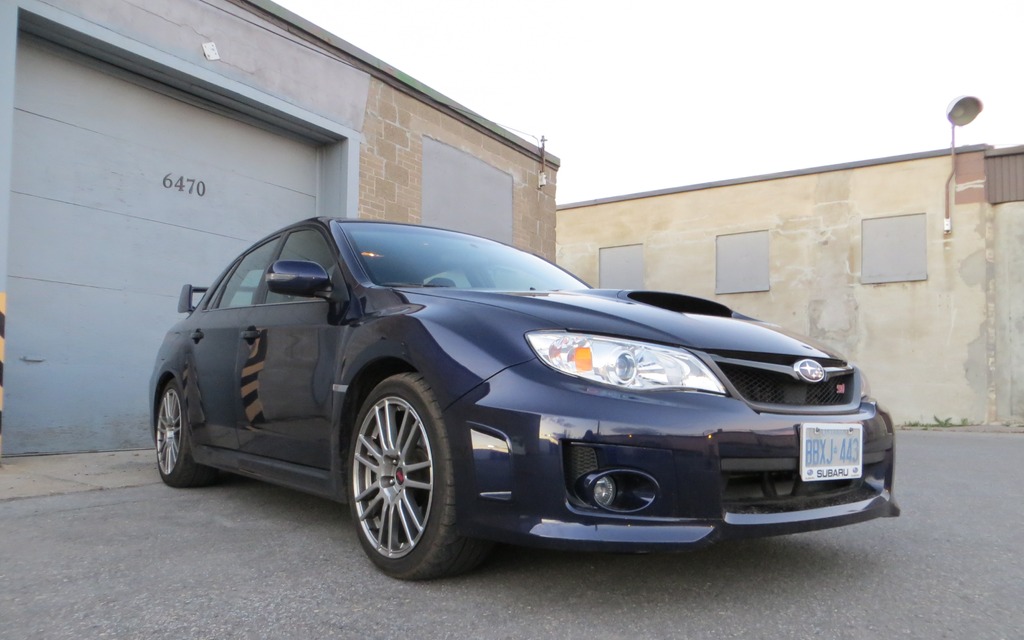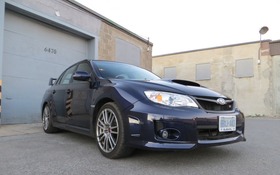2013 Subaru WRX STI: Almost Too Much Of A Good Thing

| Strong points |
|
|---|---|
| Weak points |
|
The 2013 Subaru WRX STI caters to a very specific customer: someone who wants to go quickly, in all manner of weather conditions, above all other concerns. To this end, the STI edition of Subaru’s high performance compact sedan (and hatchback) has been outfitted with exactly the type of kit this type of driver would want, including limited-slip differentials front and rear, a rock-hard suspension system, gobs of turbocharged horsepower, and the kind of over-the-top aero treatment that you really start to appreciate at speeds above 200 kilometres per hour (* allegedly).
There’s a big question mark lurking behind – or should I say, below – the Subaru WRX STI, and that’s the entry-level WRX. Cheaper, and in many ways 7/8’s the car that its big brother portends to be, there’s little question that the biggest threat to the STI’s sales figures is the sheer competence of its less-advanced sibling.
- Also: 2013 Subaru Impreza WRX: One Last Look At An Icon
- Also: 2015 Subaru WRX STI: Track-Tested At Laguna Seca
After spending a considerable amount of time with both the WRX and the WRX STI over the course of the past year, I’ve come to my own conclusions about viability of each model with respect to its expected clientele. More isn’t always more, except when it is – which points to the ambiguity inherent in crowing a clear victor in the internecine warfare engaged in by these two rally rockets.
Supersize Me, Please
I’d like to start by elaborating on what, exactly, you get from Subaru when you spend roughly $6,000 over and above the standard WRX’s starting price and park an STI in your driveway. While both versions of the car share the same engine – a 2.5-liter, turbocharged four-cylinder – the WRX STI sees its output boosted to 305 horses and 290 lb-ft of torque, which are generous increases over the WRX model’s bottom line. The car also comes with the differentials I mentioned in the opening paragraph, a six-speed manual transmission (as opposed to the WRX’s five-speed box), as well as a driver controlled center differential that is accessed via the SI-Drive system’s console-mounted, knob-and-buttons arrangement.
Moving to the chassis, the 2013 Subaru WRX STI is unquestionably tighter-sprung than the more affordable version of the car, and it also rides on 18-inch rims and benefits from big Brembo brakes. Visually, it’s impossible to miss the giant wing that’s fixed to the trunk of the WRX STI sedan (which is what I drove), although it takes a keener eye to discern that the car’s hood scoop is that much bigger than on the base WRX model. Both cars share the same wide-body look.
Extra Horses In The House
How much of a difference do forty more horsepower and 46 additional lb-ft of torque make in a straight line? According to Subaru, the WRX STI accelerates to 100 km/h in 4.5 seconds, which is just a few ticks shy of a full second faster than the baby Rex. In the real world, the answer is much more nuanced. Despite the extra grunt under the hood, I found myself having to shift the WRX STI’s six-speed transmission more often than I expected, due to the closer ratios. This often meant dropping down from sixth gear to fourth gear on the highway to execute a pass, or fourth gear to second around town should an incline present itself. The end result is more control over the powerband at the expense of smooth cruising, as you definitely notice how much harder your right hand and left foot are working.
Of greater interest to gearheads is the SI-Drive system, which offers automatic, Sport, and Sport Sharp settings. Moving from auto to Sport Sharp – especially while already underway – introduced a noticeable improvement in throttle response and acceleration. Sport wasn’t nearly quite as delineated from auto, which was actually the setting I used most often. SI-Drive also offers the ability to send more power to the front or the rear axles by way of a pair of toggle switches on the console, a feature I played with briefly but was unable to test out thoroughly in a street environment. In my opinion, the presence of SI-Drive is the biggest drivetrain divergence between the two cars, as it gives the WRX STI a definite personality all its own as well as an immediacy that simply isn’t present in the base WRX.
Lash Yourself To The Mast, It’s Going To Get Rough
SI-Drive isn’t the only easily distinguishable characteristic setting the 2013 Subaru WRX STI apart from the WRX. One only has to find a stretch of bumpy road (which Montreal has in abundance) to discover that the STI’s coarser suspension tuning is a level above that of its softer comrade when it comes to punishing driver and passengers. The unforgiving nature of the WRX STI’s chassis is perhaps the one factor – aside from price - that will push more people toward the standard WRX, as you really have to be all-in when it comes to compact performance to tolerate the rocky reception that the STI affords all but the smoothest of roads. The upside? Better grip in the corners, which manifests mostly in the form of more confident road-holding at higher speeds.
To Spend Or Not To Spend
I’ve made reference to the price differential between the WRX and the WRX STI a few times now, and that’s because it’s in a way the elephant in the room. One only has to open the door to the STI’s function-first, plastic-laden cabin and experience the truly terrible ergonomics of its Pioneer-sourced (and thankfully gone-for-2014) entertainment and navigation system to immediately begin pining for similarly-stickered performance cars like the Ford Focus ST. The plain-Jane nature of the Subaru’s passenger compartment is easier to overlook at the WRX’s price point, but it’s definitely hard to stomach in a model costing over $38,000.
There’s also the question of the aftermarket, and indeed Subaru’s own parts and tuning support for the WRX that can transform the lowly entry-level car into a formidable opponent for a stock STI. Sure, you miss out on the very trick SI-Drive, but most other performance bits can be made up for with the judicious application of catalogue dollars.
And so, it would seem that I have come round again to the gambit I laid out in the opening paragraph of this review. The 2013 Subaru WRX STI is a beacon of in-the-flesh rally championship performance for a hardcore demographic of acolytes who are willing to live with the compromises inherent in the STI’s razor-focused mission statement. It’s also the more effective lapping weapon, thanks to the customization offered by SI-Drive as well as its locking differentials and six forward cogs. For the rest of us – at least, subjectively – the WRX is both the better day-to-day buy and an equally strong platform on which to build a fully-customized track machine. I’m certainly glad they both exist, but I know which one I would want to commute to work in every day, and in the performance sedan segment that counts for quite a lot.











